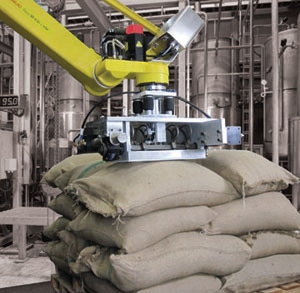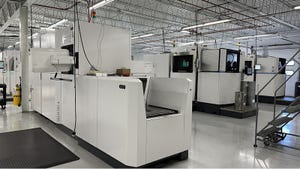April 14, 2011

The rapid advance of computer and related technologies ishaving a dramatic affect on industrial technologies such as vision systems,robotics and 3-D laser scanning. The result is that these technologies - onceavailable for use on only the highest-level projects, are becoming more viablein a broader range of applications. And as the price for a given level offunctionality and performance comes down, the payback periods for many types ofautomation projects have shortened.
As an example of how these cheaper, moreadvanced technologies are changing the game for systems designers, ConceptSystems recently developed a vision system to enable one of our clients toverify box size and the placement of labels on cases exiting a packaging line.Ten years ago, this would have cost more than $100,000 because it would haverequired multiple cameras and processors to keep up with the line speeds. Nowthe system can be built with a single camera set-up at a cost of around$30,000. The resulting system is much simpler, cost-effective and actuallyincludes even more functionality than could have been achieved 10 years agowith the more expensive system.
Computing Advances Permit New Integration Answers_A |
Robots That Handle with Care
This vision system is a good example of abroader technology trend we're seeing in new automation systems. Theintegration of machine vision with robotics for circuit board pick-and-placeapplications has been around for years, but due to limitations in processingspeed (or the cost of getting additional processing speed) these applicationshave traditionally been limited to pattern recognition technology andcircumstances where the environment can be precisely controlled. Until the lastfew years, sufficient computer power hasn't been available to cost-effectivelyenable more randomly shaped or randomly placed items to be handled. Now withthe latest technologies, robotic vision systems can be built that are moreflexible and which can tackle more complex material handling problems.
One area that is receiving an increasing amount of attention isfeeding systems. "Bin picking" is a common term which refers to the challengeof picking randomly placed objects out of a bin or tote and placing themaccurately on an infeed at production speeds. With these more advancedcomputing technologies, the challenge of picking amorphous goods off a palletand placing them accurately on an infeed at production speeds is now a reality.
Here's an example of what we'vebeen able to do along these lines. A large coffee company was having problemswith a robot that it wanted to have unload pallets of 150-lb burlap bagscontaining raw beans and then place those bags one by one on a conveyor to feeda roaster. The company's old robot followed a fixed pattern and was unable toidentify where to grab the bags. The result was that the robot ended up tearingthe bags as it tried to grip them for transport. This handling problem wascosting the company 100,000 lb of lost beans per year, and the loose beans onthe plant floor were creating a safety issue.
Concept Systems fixed theproblem by constructing a control system that uses software on a high-end PC tobuild a 3-D model of the environment in which the robot operates. Concept'sVisionFeed-3D system models each pallet of bean bags, using distancemeasurements obtained via laser triangulation. The bags are piled 20 bags perpallet in four layers of five bags per layer. A new computer model isconstructed for every tier of bags as the pallet is unloaded. The model is thenrun through an advanced algorithm that identifies unique features of the bags,and determines the precise position and orientation of each bag in that tier.The position and orientation is then used to dispatch the robot to each bag forpickup. The result is accurate bag pick-up and delivery without bag tearing orspilled beans.
Computing Advances Permit New Integration Answers_B |
The real technology challenge that this application provided isthe need to deal with the acquisition of relatively amorphous objects - thebags of coffee beans. The system does this by taking two laser images andstitching them together to eliminate shadowing from either laser. What enablesthis technology breakthrough is the fact that the system could be built withstandard off-the-shelf components: the PC, the lasers, the video cameras andthe robot. Besides eliminating the problem of torn coffee bags, the new roboticvision system can unload the pallets reliably at twice the speed of theprevious system.
Modular Technologies for Multiple Use
With the proliferation of applicationsthat use vision and laser scanning to identify the position and configurationof objects, the role of these systems in factory automation will expand tooffer contact-less position sensing to an ever broader range of applications.One principal benefit of this will be lower maintenance costs, as visionsystems can be used to monitor machine status from a safe distance and closecontrol feedback loops without being subject to the stresses that can damageother sensors.
Because their job is to solve automation problems for manycustomers, good system integrators have the benefit of being able to taketechnologies that have been applied successfully in some applications andconfigure them for new uses. This is made much easier today because there's nowa lot more modularity to system building blocks and the capabilities ofstandard system elements have increased.
Computing Advances Permit New Integration Answers_C |
Another enabler is the now-standard practice of using networks toconnect the subsystems of a machine. Besides improved reliability and lowercost of construction compared to old machines using point-to-point wiringmethods, networked machines are easier to maintain and are easier to connect toenterprise data acquisition systems.
Along with this commoditization of high-technology hardware comesincreasing familiarity. Because of these increased confidence levels, factoryowners are more receptive to using new technologies than before and there'smore confidence in systems integrators in general to apply those technologies.But how do customers know whether a particular integrator is qualified totackle a complex technical task?
The Control System IntegratorsAssn. is a nationwide organization of member companies committed to sharingbest practices in the industry. The CSIA's certified member program requiresapplicants to pass an intensive audit process that measures performance againstbenchmarking criteria in eight business areas - General Management, HumanResources Management, Project Management, System Development Lifecycle, QualityAssurance Management, Supporting Activities, Financial Management and BusinessDevelopment Management. By looking for CSIA-certified integrators, machinebuilders and owners can be assured that the new technologies they deploy willbe applied correctly to serve their needs.
Michael Gurney is the co-CEO at Concept Systems. He can bereached at [email protected].
Click here for moreinformation.
About the Author(s)
You May Also Like








